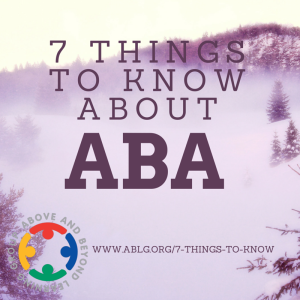
Myths and rumors about Applied Behavior Analysis, or ABA, can stop a lot of parents from seeking this effective form of therapy! Here’s a few myth busters from ABLG!
1. Applied Behavior Analysis, or ABA, is a slice of of a much larger field of study. Behavior analysis is the scientific study of behavior. This includes behavior in AND out of the lab. Applied behavior analysis is the study of behavior in settings that matter to humans, basically. In other words, how do we take all the great information we got in the lab and apply it to reading, speaking, living, interacting…?
2. ABA therapy, when implemented for individuals with Autism, does not produce robots. That said, bad practitioners get bad results. ASK your practitioner how s/he will ensure generalization of the skills learned in therapy.
3. ABA can’t live in the therapy session. ABA is often done in “sessions” like traditional therapy. However, we see the most successful outcomes when parents and caregivers carry over the skills outside of the therapy room. Period. We don’t mean to be confrontational. The fact of the matter is that one of Autism’s core deficits is a failure to generalize. We have to make generalization happen, or else what happens in therapy, stays in therapy. And since therapy is not Vegas, please plan to sit in and get dirty.
4. Your BCBA (Board Certified Behavior Analyst) and team want to be ultra-sensitive to what you can and can’t put in place at home. That said, when they make recommendations, they’re empirically validated. Meaning, proven. When we water them down, make too many compromises, or go too far to accommodate you, the interventions aren’t going to work as well. Truth.
5. “Fading out” is a thing. A real thing. It’s not a grand idea to “yank” ABA therapy without a specific plan to fade out. When we pull a program or skill without a fade out procedure, all that time and effort spent teaching the skill pretty much goes to waste. Plus, it’s important to see how a client reacts to having therapy reduced ~ yanking therapy or a skill can cause all kinds of regression! It’s also not a great idea to start and stop programs ~ they can take time and tweaking to teach.
6. It’s better NOT to have a behavior intervention plan, than it is to start one that you can’t follow through with. A behavior plan that is going to be implemented inconsistently will do more harm than good. You just have to trust us on this one.
7. 2 hours of therapy a week is not going to be effective. It might be completely overwhelming to hear that your 3 year old needs 30-40 hours per week of therapy! But the last thing you need to know about ABA is….
8. BONUS: ….ABA therapy isn’t just sitting at a table learning academic skills. It includes:
Getting dressed
Holding the door for people behind you
Recognizing personal space
Safety skills
Play Skills
Listening to directions from a distance
Putting on shoes and jackets independently
…pretty much everything that a child diagnosed with Autism needs to learn how to do. In many all-day ABA programs, the therapists “shadow” the client to teach everything that typically developed children do in a day. When you think of it that way, 30-40 hours a week makes much more sense.
What are some common myths about Applied Behavior Analysis that you’d like to see vanish?
Are You a Visual Learner? Check out our VLOG on ABLG TV.

We used sign language with our son too – at that stage he was Dx as svreee language disorder but is now going through Ax for high functioning autism. We probably used it for up to 2 years and then it naturally petered off. He loved it being very visual – he would sit and watch the training video.